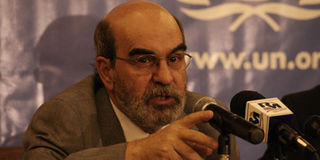Food crisis looms, warns UN report

PHOTO/FILE
FAO director-general Jose Graziano da Silva addresses a news conference on Friday at the Nairobi Serena hotel on the food situation in Africa.
Kenya’s arid and semi-arid areas could be facing yet another food shortage even as the government and relief agencies fight to provide lasting solutions to residents.
According to the Horn of Africa Crisis Situation Report by the United Nations, drought conditions in the northern, north eastern and southern parts of Kenya have significantly eased following good rainfall in the October-December short rains season.
But, the report warns, a food crisis still looms in the region as a result of dry spells forecast for the coming months.
Things may have improved, but the few gains made are slowly being reversed.
By July last year, just weeks before the Kenyans for Kenya Initiative was launched, more than 3.75 million people in arid and semi-arid districts were in dire need of food assistance.
Malnutrition rates were at emergency level. More than 385,000 children under five in 13 districts were suffering from acute malnutrition.
The government consequently declared the drought a national disaster.
The Kenya Red Cross (KRC) says malnutrition levels in the affected areas have dropped significantly from 37.4 per cent to 13.7 per cent – which is still a long way from a situation in which all citizens have access to good nutrition and clean drinking water the year round.
At the height of the private sector-driven Kenyans4Kenya initiative to which thousands of Kenyans donated hundreds of millions of shillings, it was agreed that some of the funds would be used for starting up projects to provide long-term solutions.
However, these projects will not be functioning any time soon, according to a KRC spokesperson.
“We do not expect some of the communities in which we have set up these projects to experience hunger. For most of them, the problem will be getting a market and storage facilities for any surplus produce that they might get,” said Mr Fred Gori of the necessary in a majority of regions.
"Warnings have already been sounded for some of them ...”
Turkana Central constituency was among the most severely affected by last year’s famine.
At the height of the crisis, a list of long-term projects was drawn up to help the population become self-sufficient in food production.
The plans to create irrigated production areas, dig boreholes and other efforts that could establish more sustainable ways of life are yet to come to fruition, says Turkana Central Member of Parliament Ekwe Ethuro.
Among the projects on paper is a Sh34 million irrigation scheme on the River Kerio.
The cost represents just over 10 per cent of the total collected in the Kenyans4Kenya drive that is supposed to have gone towards long-term projects.
A huge chunk of the Sh300 million intended for this project is yet to be disbursed.
But even as another hunger crisis looms, KRC says more preparation is needed before these projects can begin.
“We have been charged with investing a lot of other people’s money in these ventures. Due diligence must be followed. A proper assessment needs to be done. At such times, it is very easy to end up with white elephants,” Mr Gori said.
Turkana North MP Joshua Nanok fears the worst.
“We know that hunger is upon us. The government and a few relief agencies continue to provide food rations against a backdrop of shrinking pasture and reducing water.
"Soon we will be grappling with insecurity issues. Two kilos of maize meal will be of little significance if the recipient does not have a place to prepare her meal,” he said.
Last year, as relief food left Nairobi for the regions in need, there were concerns about insecurity and poor infrastructure. Nothing much has changed since then.




